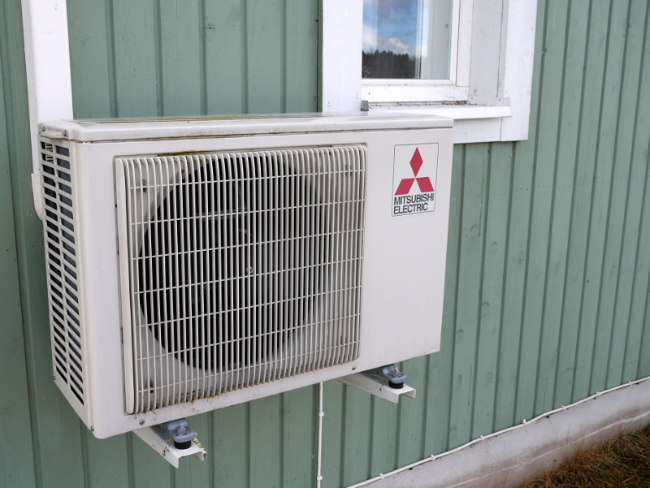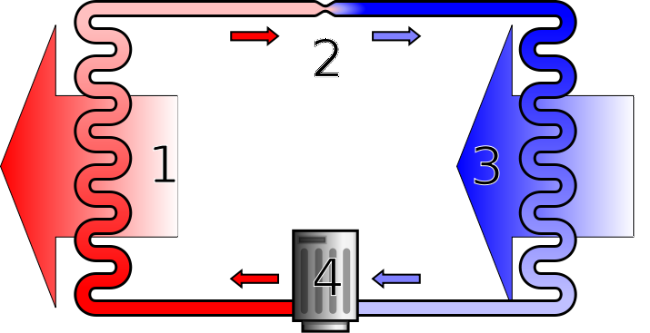Heat Pumps Now Cheaper Per BTU Than Natural Gas
| . Posted in buildings, News - 43 Comments
We all know electric resistance heat is very expensive. In Massachusetts, the average utility rate is 19.6 cents per killowatt-hour ($0.196/kW-h). This means a house that spends $1,200 in a winter on natural gas would spend over $6,000 on electric resistance heat. But have you heard of the electric heat pump (aka ductless mini-split)?

Mitsubishi Electric heat pump - CC-BY-SA-4 by Santeri Viinamäki
How Does a Heat Pump Work?
A heat pump is an air conditioner that runs backwards.
In a normal air conditioner, electricity is used to move a working fluid in a cycle. The fluid gets heated and cooled as it travels in a loop.
Electricity drives the compressor, which pressurizes and heats the fluid. The fluid gets hotter than it was before, hotter even than the exterior temperature. It flows through a heat exchanger with the outside air and heats the outside slightly. It loses some temperature. This is how it moves energy outside.
Then the fluid runs through an expansion valve, where it loses pressure and lots of temperature. It runs through a heat exchanger inside. Heat moves into the cold fluid from the warm room. This is how it takes energy from the room. Then the fluid reaches the compressor and the cycle repeats.
Air conditioners have a “coefficient of performance.” You might use half a unit of electrical energy to drive the compressor. You might be able to move two units of heat from inside to outside. This would be a “coefficient of performance” of (two divided by one-half equals) four.
A heat pump can heat an apartment by running a special air conditioner backwards. The cold part of the cycle is colder than the coldest winter day. Heat moves into the fluid from the outside air. The warm part of the cycle is warmer than the room. Heat moves from the fluid into the room. The cycle repeats.
Until recently, heat pumps could not get cold enough to extract heat from the outside. But recently, hundreds of models of heat pumps have been cold-climate rated. This means Massachusetts landlords now have another choice to consider when upgrading heating systems.
The Northeast Energy Efficiency Partnerships (NEEP)
NEEP publishes a list of cold-rated heat pumps. The average ductless pump on their list uses 283 Watts at 5 °F and delivers over 4,400 btu/hr. On a cost per BTU basis, this is $12.61/MMBTU, for the first time ever, on-par with natural gas.
And Good News, Electricity can be Free
Solar panels provide a way to generate some or all of your electricity for free. Because of heat pumps’ new cold-rating capability, solar means we can generate some of all of our heat for free.
Implications for Owners
Owners with separate meters typically have their tenant to pay for heat. The first owners to switch to solar-powered heat pumps might nevertheless enjoy an advantage over other owners slower to adapt.
Consider that the average apartment uses natural gas, oil, or electric resistance heating to stay warm. Tenants price these costs into their apartment decision when they shop. If you offer a more efficient heat source, you can demand higher base rent.
If you go solar, wind, or water-powered to produce your own electricity, you can sell your energy onto the grid and allocate your owner’s meter credits to the tenant’s bill. You can then charge the tenant for that electricity. The separate meter keeps the incentive on the tenant to reduce consumption. The charge gives you an additional revenue source.
Because heat pumps are fundamentally more efficient that other sources, on a per btu basis, your tenants will be paying less for their heat than they would elsewhere. Also, because they can run backwards as air conditioners, you no longer need to permit window units. This will tend to lower your vacancy rate and window repair costs, and keep your tenants happier.

Hot fluid (1) transfers heat to sink, expands (2), takes in heat at source (3), and is compressed (4) to repeat. Ilmari Karonen.
Heat Pump Limitations
Efficiency in this case is a limitation. Heat pumps are not like furnaces or boilers, which cycle on and off in powerful blasts. Heat pumps are meant to run continuously at high efficiency. If you do not have a well-insulated house, it will take a long or never-ending time for a heat pump to bring an apartment up to code. This means you want to consider heat pumps for rentals only in combination with wall insulation and air sealing.
Interior shape is another limitation. If your apartment floor-plan is not mostly square, or if you cannot locate the interior heat exchanger centrally, you will need two or more exchangers inside the unit. This will drive up your capital cost to install these systems.
Snow is a final limitation. Heat pumps are typically installed on the ground. Be careful! You will need to cover them with a hutch or install them above snow-drift. They cannot work well if their external heat exchanger is covered in snow.
Heat Pump Conclusion
For the first time, electric heat pumps offer parity with natural gas for cost per BTU on average. Use extreme care when selecting a model, because your heat load might require a less efficient model. But the opportunity is now arriving. In combination with insulation and a move to solar, heat pumps offer owners and managers an intriguing option for competitive advantage.




